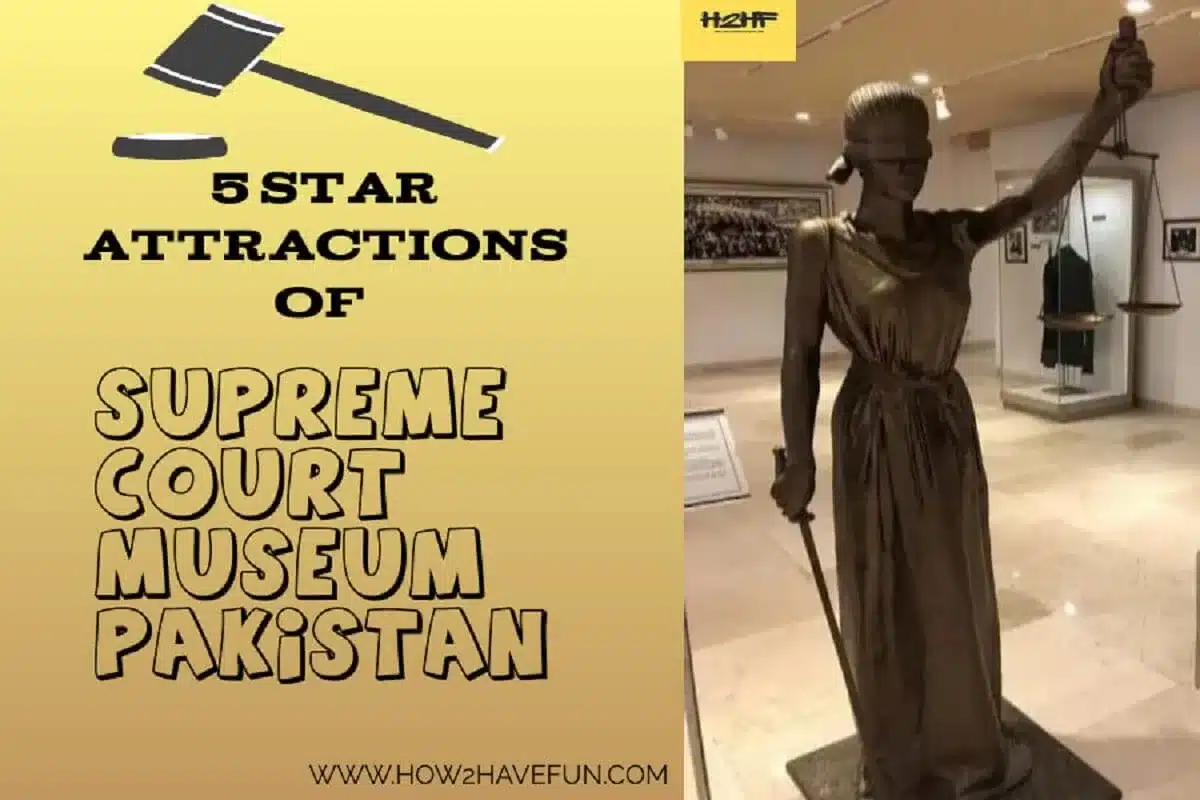Supreme Court Museum Pakistan : 6 Star-Attractions
Every civilized country has a supreme court museum to remind their people that justice will served to all equally – but is justice being served?
.jpeg)
1973 Pakistan Constituent Assembly that Framed the Constitution
Table of Contents
ToggleSupreme Court Pakistan Architecture
The Building of the Supreme Court has high ceilings with exquisite calligraphy, polished marble flooring, and natural light from large windows that generates awe and devotion.

Highlights of the Pakistan Supreme Court Museum
The museum has some of the highlights of the museum include:-
1. Timeline of Pakistan’s judiciary
2. Evolution of law
3. Constitutions of Pakistan,
4. Famous trials of the British period,
5. Kashmir sale deed by the British to the Hindu Dogra
6. Quaid-e-Azam’s enrollment with the Federal Court of India,
7. Landmark judgments of the Supreme Court of Pakistan
8. A reproduction of the frieze of lawgivers a sculpture depicting 18 historical characters who helped shape law and justice for the civilized world. The Supreme Court of the United States displays the original frieze, with:-
-
-
Prophet Moses
-
Hammurabi
-
Confucius
-
Juvenal
-
Prophet Muhammad PBUH
-
Napoleon
-
and John Marshall.
-
.jpeg)
Freize of Lawgivers
Starting right to left, the first one was The Byzantine Emperor Justinian who compiled the Roman law into a book.
The 2nd image was supposed to be of Prophet Muhammad (c. 570) but that image has been omitted from this replica.
No 3 in line is Charlemagne who united Europe by c. 804 under a civilized rule of law.
Further ahead are images of King John c 1199, holding his Magna Carta of constitutional liberty.
King Louis (c.1297), set up the Court of Appeals, and Hugo Grotius (c.1583-1645) wrote an influential book on international law in 1625.
I didn’t know Napoleon (1769-1821) was the architect of modern French society. He compiled the French law under a ‘civil law’ chapter and was very proud of it; ‘what nothing will destroy, what will live till eternity, is my civil law’
.jpeg)
The Frieze in US Supreme Court Building
There is another frieze in the US Supreme Court that talks of:-
-
Menes (3200BC)
-
Hammurabi (1700 BC), the king of Babylon
-
Prophet Moses (1300 BC)
-
King Solomon, 900 BC (‘the judge’),
-
Lycurgus (800BC)of Sparta
-
Solon (594 BC) of Athens.
-
Draco (600 BC): introduced punishments for infringements, therefore the term ‘Draconian’.
.jpeg)
Code of Hammurabi
The code of Hammurabi (1754 BC) is significant because this Babylonian king established the rules, wages, and punishments for a civil society. This tablet consists of 282 laws, graded based on social status, gender, and slave versus free, etc.
.jpeg)
About 50 % is matters of contract like wages of an ox-driver or a surgeon etc. The most interesting part is it says that a judge who alters his decision after it is written down is to be fined and removed from the bench permanently.
Museum Conservation Laboratory
.jpg)
The museum’s conservation lab uses sophisticated methods to preserve its collections.
Inspiring Leaders of Supreme Court Pakistan
The display includes narratives of individuals who built Pakistan’s legal environment. These examples show how the human spirit can overcome hardship:-
-
Chief Justice Anwarul Haq’s defiance of martial law
-
Asma Jahangir’s relentless advocacy for women’s rights.
.jpg)
The museum also commemorates the judiciary’s sacrifices and contributions to national development.
Famous Quotes on Justice and Law
-
“I advise you to show respect to the rights of women and fear god about them… you have certain rights with regards to your women, but they also have rights over you” Prophet Muhammad PBUH
-
“Justice delayed is justice denied.” English jurist William Blackstone.
-
“No one is above the law.” Mukarram Jah, Pakistani lawyer and human rights activist
-
“Please respect the rights of women and fear God concerning them. You have rights over your ladies, but they have rights over you.” Caliph Umar (RA)
-
· “Government alone cannot do it. Only the people must use legislation to deliver justice to the country’s enormous masses.” Justice P.N. Bhagwati, former Indian Chief Justice
FAQs on Supreme Court museum:
People usually ask these questions about the Pakistan Supreme Court:-
Who made the Supreme Court Pakistan Building?
After President Ayub Khan opened the Supreme Court’s first structure in 1964, the museum was curated at its furthest corner.
Why is the Supreme Court Museum there?
The Supreme Court Museum promotes justice and equality, educates the public about Pakistan’s legal history, and inspires future generations.
When is the Pakistan Supreme Court Museum open?
Monday through Saturday, except Friday, from 8:30 am to 3:30 pm, the museum is open.
What is the ticket price of the Supreme Court Museum Pakistan?
Everyone enters for free. To enter, visitors must produce their original CNIC
How do I get to the museum?
The Supreme Court Museum is on Constitution Avenue in Islamabad. Easily accessible by taxi or public transit.
Conclusion
In conclusion, the Supreme Court Museum symbolizes the strength of justice and the search for truth. I hope the honorable judges develop enough spine to bring all the constitutional violators to justice to honor the martyrs of rule-of-law
The part I liked was biryani at their cafeteria hall with raita and tea.
Also see, Secret of a Nation’s Success
